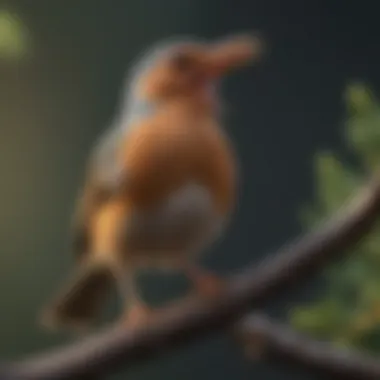Mastering the Art of Bird Call Identification


Intro
Identifying birds by their calls is an enriching skill that can deepen anyone's connection with nature. While visual identification is often emphasized, the ability to recognize different bird calls can be equally—if not more—valuable. An understanding of beats, rhythms, pitches, and structural properties of calls can provide insight into not only which bird is present but also its behavior and intent. This article resources approaches, practical tips, and essential tools to successfully identify and appreciate avian communication through sound.
Care Tips
To become adept at recognizing bird calls, it's important to approach learning with both practice and self-care in mind.
Daily Attention to Soundscapes
Adopting a routine that immerses you in your environment will assist your auditory recognition skills. Spend time outside during different times of the day. This exposes you to various calls and activations, heightening your sense of awareness.
Steady Environment
While participating in fieldwork or outdoor birdwatching, a calm and prepared environment contributes to insightful observation. Shrubs and open fields matain ecologic settings where sounds are loudest. Observing the chilling effects that distractions bring about will also enhance your insightful hearing.
Care for Recordings
When you record bird calls for future reference, be sure to store your recordings in an organized manner. Use folders labeled with the respective bird genres or ecosystems observed. Keeping notes alongside your recordings will enrich temporal understanding of bird calls. Every detail counts, like weather conditions or times of day when calls were recorded. These details furnish a fuller context to your recordings —critical for analysis.
Tip: Consider using an app to compare recorded calls with your observations. Apps like Merlin Bird ID can offer side-by-side sound comparisons.
Behavioral Insights
Understanding the calling behavior of birds is just as essential as recognizing the calls themselves.
Call Purpose
Bird calls serve multiple functions beyond simply attracting mates. Birds call to establish territory, signal alarm, or show social cohesion. Notably, alarm calls vary between species; for instance, robin calls can signal the presence of specific predators, creating anticipatory behaviors among flocks.
Interpreting Calls
Listening in context is vital. Learn not only what a call sounds like but also when. Breeding season calls often differ from winter hoots. Being attuned to seasonal patterns allows for a comprehensive approach to call quiring the right expertise.
Common Behavior Issues
Sometimes, unfamiliar calls can cause confusion. Birds exhibiting consistent territorial or alarm calls indicate healthy behavioral patterns. If inadvertently confronted by intrusive behaviors, observe the situation, communicating changes and adaptations effectively can forge better interaction between potential avian communications.
Nutrition Guides
Though this section primarily takes the ambitious aprender towards significant facts related to bird communication, observing how diet implications access more proficient call articulation is essential. Adequate nutrition allows powered vocal development and influences call volume and frequency.
Essential Diet Components
An appropriate avian diet components various grains, herbs, and seeds foster vibrant utterances. Unknown seasons and neglect can jostle vocal characteristics.
Toxic Foods
Conversely, understanding negligent foods that have detrimental effects on bird health heals interrelation between food expectations and likely innovation done vocally. Avoid giving your birds chocolate, avocado, or onion, as toxicity can threaten their vocal prowess.
Wellness and Health
Regular observation and checkups are essential in linked statistics with call effectiveness=status. Birds in ideal health often display more vivid and diverse calling patterns. Keeping detailed health records will signal potential issues and support timely interventions. Calls that seem to shift in tone can be indicative of distress or illness.


Enriching Activities
To augment your auditory appreciation of birds, it's advisable to engage in several exercises that reflect their needs and structural routines.
Puzzle Play
Use toys to aid enrichment, engaging their natural instincts while bolstering growth leads to environmental familiarity: Hanging mirrors Colorful swings
Explore Outdoor Settings
Take advantage of your surroundings by frequently heading off into areas where birds congregate, whether parks or nature reserves further enhance your evaluation of auditory cues and appropriate speak habits. Embrace nature leisurely without technologically characteristic distractions; diving into environmental soundscapes lifts auditory tools exponentially.
Final equipped passages leave you sound-aware. Identifying what calls share means enlightens utilization. Owning unique environments ultimately conveys endpoints not just as backdrop; varied evolutions located scenery each elements rhythm contribute best, providing essentials listed towards fostering articulate goals.
Understanding Bird Calls
Identifying birds by their calls provides a deeper connection to nature. For birdwatchers, understanding bird calls can be as crucial as matters like appearance. Their calls often convey essential information about behavior, location, and species interactions. Developing the ability to recognize these sounds can enhance the overall birdwatching experience.
The Importance of Bird Calls
Bird calls play significant roles in the lives of birds. According to scientific research, these vocalizations are used for various communication purposes. Being aware of this helps in understanding avian ecology. Recognizing a call can intergoogle bird watching skills and enhance enjoyment during the process. Listening carefully can lead to identification in the field and foster inclusion in community discussions about birds.
Types of Calls and Songs
Birds use different types of calls for various situations:
- Distress Calls: Distress calls indicate danger. When a bird feels threatened, it emits a loud and often high-pitched sound to alert other birds. This call serves as a warning signal, helping ensure the safety of community members. Such calls can be high in pitch and are designed to attract attention from nearby birds. Its main advantage is the quick dispersal of warnings. Lack of subspecialization among different species, however, can lead to confusion about exact etiology.
- Mating Calls: Mating calls are essential during mating seasons. These calls are designed to attract potential partners and can be unique to species. For instance, male birds often call in melodic ways to showcase vitality to female birds. The distinctive characteristics vary in volume and tone. They can be helpful during birdwatching since they occur predictably during specific seasons. However, males might face the risk of predation while participating.
- Territorial Calls: Territorial calls establish boundaries. The specific sounds produced indicate a “no trespass” zone. Birds use these calls when competitors approach. This established vocal barrier helps avoid conflict. Territorial calls often exhibit pronounced characteristics based on region, giving distinct parameters to land users. Thus, observing territorial call patterns helps characterize ecological study zones.
- Contact Calls: Contact calls maintain flock cohesion. These shorter, less aggressive sounds allow birds to keep track of each other while foraging or flying. Birds use soft contact calls to convey information such as “all safe” or “stay close.” The regular appearance of these calls promotes teamwork within flocks, similar to human communication systems. Their simplicity might lead to utilitarian functions rather than complex meanings.
Understanding Call Structure
Understanding the structure of a call enhances identification:
- Pitch: The pitch of a sound relates to how high or low the tone is. Higher pitches usually convey more excited or alarmed states. Each species exhibits specific pitches. This aspect can be critical when distinguishing similar-sounding birds. However, environment factors may alter perception of true pitch.
- Duration: Duration indicates how long a call lasts. Some calls are short, while others are prolongated. Brief calls may mean alerting sounds, while longer ones might imply communication. Knowing the duration of a call allows identification, although repeated trials sometimes lessen the memorization of longer sounds.
- Rhythm: Rhythm encapsulates the timing and spacing within calls. Birds may call with varied patterns. Variability in calling speed can express different moods or situations. This irregularity becomes important during quiet observation since timing itself becomes an analytical factor.
- Tonal Quality: Tonal quality refers to the specific texture of a bird's sound. Is it harsh or smooth? A soft tone can portray gentleness, while a sharp or buzzing tone might imply threats or alarms. The way tone interacts can unveil information about earthy wariness or boldness during particular times.
Identifying different aspects of bird calls not only alleviates personal interest but fosters community engagement and conservation efforts.
Techniques for Identifying Bird Calls
Understanding the different techniques for identifying bird calls is essential. It offers both amateur and experienced birdwatchers tools to enhance their birding practice. Listening and recognizing various bird calls helps observers connect better with nature. Furthermore, these methods improve the accuracy of species identification and contribute to conservation efforts.
Observational Listening
Observational listening is a fundamental technique for bird call identification. This practice encourages individuals to immerse themselves in their surroundings. By training their ears, birdwatchers can recognize patterns in different calls over time. Focusing on sound slightly distanced from a river or following a gradual wind assists in creating a mental catalog.
Important factors related to observational listening include:
- Quiet environment: Reducing background noise makes calls easier to identify.
- Repetitive patterns: Many birds repeat their calls, which aids memory retention.
Using Field Guides
Using field guides serves as an invaluable resource in learning bird calls. These guides, often available in print or digital formats, offer illustrations and descriptions of various species accompanied by their identifiable calls. Identification through visual aid combined with auditory recognition is highly effective.
Popular field guides often include:


- Illustrations of species their vocalizations.
- Regional-specific calls, as some birds vary by location, adding detail to knowledge.
- User-friendly layout for quick reference in the field.
Recording and Playback
Recording and playback gain significance when aiming for a deeper understanding of bird calls. With advancements in technology, capturing sounds has become more accessible. This method not only aids personal study but encourages documentation and sharing within the community.
Mobile Apps for Recording
Mobile apps for recording are prominent in today's birdwatching endeavors. Applications such as Song Sleuth and Merlin Bird ID simplify capturing calls, transforming a smartphone into a portable audio recorder.
A key characteristic of these apps is their ability to analyze sounds and offer potential species matches based on recordings.
- User-friendly: Many apps compel quick accessibility, reducing the complexity involved in recording.
- Real-time feedback: They allow budding birdwatchers to instantly compare their recordings against birds in the area.
Unique features may include the ability to share recordings on platform like Reddit for assistance from the community. However, a significant disadvantage arises from settings with multiple overlapping calls, which might confuse automated matching capabilities.
Playback Methods
Playback methods became crucial by allowing birders to reproduce calls in different scenarios. Utilizing recorded calls promotes additional interest and dialogue with local species. It is a valuable pedagogical tool for engageing family members or peers about resident avian life.
One important characteristic is this technique's capacity to elicit responses from local birds. Many species reinforce territory vocalizations upon hearing their calls, making identification more feasible.
- Versatile function: Whether in the backyard or on a guided group tour, wider use has established playback methods as commonplace.
- Engagement opportunity: Encourages awareness within tight-knit outdoor communities, like Facebook birdwatching groups.
However, there are ethical concerns tied to playback. Overstimulation if uses frequntly the surrounding mating season may disrupt normal behavioral patterns. Thus, discretion is essential when employnig this technique.
Documents and Resources for Learning Calls
Auditory Databases
Auditory databases serve as essential tools in the identification process. These databases collect a wide range of bird calls and songs from various species. A comprehensive database may include recordings from countless environments. Accessing these databases allows birdwatchers to familiarize themselves with different calls. Furthermore, auditory databases often provide options to filter by region, species type, or call category. This characteristic helps targeted learning. Natural curiosity leads many to explore these databases, making them a popular choice among bird enthusiasts.
Sound Analysis Software
Sound analysis software offers advanced tools to dissect bird calls. This kind of software can visualize sound waves, revealing details behind every call. By using visual representations, callers can analyze attributes like positons and harmonics. Additionally, software packages often come with frequency analyzers and spectrogram capabilities. This depth provides better insight into the pitch and tonal characteristics—a crucial element for identification. As a result, such software can be a methodological addition to a birdwatcher's toolkit.
Community Resources
Online Forums
Online forums create a unique space for bird lovers to connect, share, and learn about bird calls. Forums allow discussions on recent experiences, tips for identification, and challenges faced along the way. The key characteristic of online forums is their community aspect which encourages collaboration. Questions posed in real-time can often receive responses from experienced members. Even novice birdwatchers find valuable insights here. While these forums can become overwhelming due to extensive discussions, their richness provides engaging opportunities.
Birdwatching Clubs
Birdwatching clubs present another valuable avenue for learning bird calls. These clubs often arrange outings where members can practice recognizing calls together. Practicing in a group creates an environment that fosters learning and keeps participants motivated. A key feature of such clubs is collaborative learning since each member brings individual knowledge. Whether local or regional, clubs form small support networks for enthusiasts. While they can vary in commitment required, they offer access to experienced members willing to assist emerging birdwatchers.
Practical Applications of Bird Call Identification
Understanding the practical applications of bird call identification has considerable importance, particularly in enhancing experiences related to birdwatching and promoting conservation efforts. Knowledge about bird calls equips individuals with the ability to identify avian species in their environment. This allows for a greater appreciation of biodiversity. It ensures that the observer is actively involved rather than passively looking for visual cues. Learning to identify birds by their calls can also promote networking among community members and enhance engagement with nature on a deeper level.
Enhancing Birdwatching Experiences
Identifying birds by their calls leads to improved birdwatching experiences. When birdwatchers recognize birds without needing to observe them, it enhances overall enjoyment. Observers can appreciate the variety in nature without disturbing their space just by listening. The added layer of understanding transformations in calls during different seasons only adds to the knowledge base. Recognizing the calls of various birds adds depth to any birdwatching activity. Whether it’s a quiet chirp in the early morning or a cacophony of sounds during migration, listeners can appreciate these moments acoustically.


Conservation Efforts
Bird call identification plays a critical role also in conservation. Concerted efforts in research showcase how vital community involvement can be in preserving avian species. More awareness stems from enhanced identification skills, contributing to significant observations in the field. Let's delve deeper into specific aspects of conservation that benefit from identifying bird calls.
Monitoring Species Populations
Monitoring species populations benefits immensely from understanding bird calls. Each species has distinct calls that contribute to the overall metrics of population health. The ability to discern these calls aids researchers and conservationists in tracking changes in populations effectively. This primary indicator allows for timely responses to population declines, making it a popular approach for ecological studies. Additionally, quick assessments through auditory means are less intrusive to bird habitats than capturing individuals for study. Thus, this method makes ecological research more ethical and sustainable.
Habitat Preservation
Habitat preservation focuses on safeguarding the places where bird species thrive. Regular monitoring through bird calls supports efforts to recognize and protect vital habitats. Understanding calls may help conservationists pinpoint areas of high biodiversity and shifts in habitat use driven by various pressures such as climate change or urban expansion. Recognizing unique indicators present gives clarity to specific habitat needs during various life stages for different bird species. Conversely, challenges may arise with variations in calls due to environmental shifts leading to loss of habitat awareness.
Family and Community Engagement
Bird call identification stands to foster family and community engagement with nature. Involving families in learning these skills cultivates interests in environmental studies and conservation from an early age. When community members unite their knowledge of bird calls through communal activities, larger awareness is initiated regarding local biodiversity efforts. This initiative serves to excite wildlife advocates and transforms simple birdwatching into platform for communal growth. Families keen to learn actively engage while enriching their understanding not only of their environment but also fostering deeper relationships within their local communities.
Challenges in Bird Call Identification
Identifying bird calls is not an easy task. Various challenges can complicate the process, making it crucial to understand these obstacles. Some of these challenges arise from external factors in the environment, while others are rooted in the complexity of bird species themselves. Recognizing these challenges prepares the birdwatcher for a more constructive learning journey.
Environmental Interference
Environmental interference plays a significant role in the obstacles faced when identifying bird calls. Factors like wind, nearby traffic, and urban noise can distort sounds hear in nature, making certain bird calls hard to distinguish. In natural habitats, plant life or other wildlife may also mask sounds.
It is essential to consider the time of day and season while birdwatching. For example, during dawn, increased ambient noise might interfere with clearer call recognition. Birds often adjust their calls based on environmental sounds which makes it hard to isolate individual calls. Identifying a call among diverse sounds can be another layer of difficulty. Having awareness of these external factors can enhance awareness and improve identification efforts.
Species Complexity
The complexity inherent in bird species poses another challenge in call identification.
Similar Species
Similar species often share distinct audible traits. This commonality may present significant difficulty. For instance, some warblers possess calls that sound very alike. This resemblance can cause confusion among observers, particularly those who are less experienced. The key characteristic of such species, is frequently the tonal quality or rhythm present in their calls.
They might also mimic other species calls. Such behavior complicates identification further. One disadvantage for amateur birdwatchers is that variations in these calls might cause misidentification over time.
Regional Variations
In different geographic locations, similar species may develop unique call patterns. This variation means the 'standard' call might differ, depending on the region. For example, the distinctive call of an American Robin may sound different in varying states or countries. Recognizing regional variations helps birdwatchers create a more nuanced understanding of identification.
In some cases, this complexity also functions as a challenging factor. Observers might need deep knowledge to differentiate calls that are similar in one area compared to another. Finally, a solitary call might not carry the same meaning across regions, potentially leading to misunderstandings. Addressing regional differences can be essential when learning successful bird call identification.
Future Trends in Bird Call Recognition
Bird call recognition is evolving, driven by new technologies and the increasing participation of citizens in biodiversity efforts. Understanding these future trends can significantly enhance how we identify and appreciate birds, making our interactions with nature richer and more informed. This is crucial as our knowledge contributes to conservation measures and fosters a greater appreciation for avian communities across various environments.
Technological Advances
Technology plays a pivotal role in revolutionizing bird call recognition. With the emergence of sophisticated mobile applications and audio analysis tools, birders can now access vast libraries of bird sounds.
- Machine Learning: Many systems are using machine learning to identify birds by sounds. Algorithms can analyze the frequency and patterns, differentiating one species from another effectively.
- Mobile Applications: Apps like BirdNET and Merlin Bird ID enable users to record calls and receive instant analysis. These resources work on smartphones, creating a handy tool for both amateurs and experienced birders.
- Database Expansions: Online databases continue to grow, providing easier access to a plethora of bird calls stored in auditory cloud systems. This advancement fosters community learning as anyone can explore and compare sounds from all around the globe.
In leveraging technology, bird watchers enhance the accuracy of identifications while enjoying the process. To get more adept, remembering that technology is there to support, rather than replace, keen auditory skills might be essential.
Citizen Science Initiatives
Citizen science has paved new pathways for the recognition of bird calls. Numerous projects invite ordinary people to participate in data collection and analysis using their observations. This trend represents a collaborative effort in understanding and conserving bird species.
- Engagement in Unique Opportunities: Initiatives allow participants to engage with local wildlife. Volunteers with varying expertise can contribute meaningfully, promoting inclusivity.
- Methods of Contribution: Through auditory data collection utilizing apps or tools, individuals contribute to research initiatives. This participation broadens the dataset available for auditing species worldwide.
- Partnerships with Institutions: Many ecological and ornithological institutions capitalize on citizens’ contributions. By analyzing recorded calls, researchers uncover patterns related to migration, breeding, and habitat usage.
As engagement grows, so does the potential for research—bridging the gap between the scientific community and the public. Furthermore, these collaborations help raise awareness of predominately ignored or unknown species, creating holistic ecologies.
In summary, the future of bird call recognition is intertwined with technological progression and community involvement. Together, these elements can reflect on conservation efforts and increase the sense of connection to nature.















